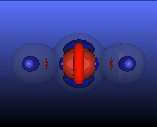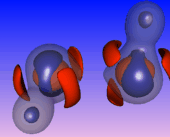

Four views of the Laplace field of H2O in the ground state.
H2O


Four views of the Laplace field of H2O in the ground state.
The blue surfaces surround regions of electronic charge accumulation (div(grad(rho)) < 0), the red surfaces surround regions of charge depletion (div(grad(rho)) > 0), and the transparent surface is at div(grad(rho))=0. The blue surfaces surround the bonds, the lone pairs, and the nuclei (there is a hidden blue surface around the core of the oxygen).
The molecule was optimized using gaussian 94 running on an iris indigo 2 at the b3lyp/6-311++G(2d,2p)//b3lyp/6-311++G(2d,2p) level of theory. The visualization was rendered using fast.
Here is a vrml version of a similar visualization, at lower resolution.


Four views of the topology of the Laplace field of H2O.
The transparent pink surfaces isolate regions of electronic charge accumulation (div(grad(rho)) < 0). Local maxima of charge accumulation are shown using small blue crosses. The blue crosses reveal the HO bonds, the Oxygen's lone pairs, and the core densities around the nuclei.
The calculation was performed using gaussian 94 running on an iris indigo 2 at the b3lyp/6-311++G(2d,2p)//b3lyp/6-311++G(2d,2p) level of theory. The visualization was rendered using fast.

Two stereo views of the topology of the Laplace field of H2O.
The blue surfaces surround regions of electronic charge accumulation (div(grad(rho)) < 0), the red surfaces surround regions of charge depletion (div(grad(rho)) > 0), and the transparent surface is at div(grad(rho))=0. The blue surfaces surround the bonds, the lone pairs, and the nuclei (there is a hidden blue surface around the core of the oxygen).
The local minima of the laplace field are shown using bluish crosses, the local maxima using pink crosses, and the saddle points using crosses of mixed color depending on the index of the saddle.
The molecule was optimized using gaussian 94 running on an iris indigo 2 at the b3lyp/6-311++G(2d,2p)//b3lyp/6-311++G(2d,2p) level of theory. The visualization was rendered using fast.
C6H4

Two stereo views of the topology of the Laplace field of ortho-Benzyne C6H4.
The surfaces are colored as for water, above.
In the leftmost pair of images the local minima of the laplace field (maxima of charge accumulation) are shown using bluish crosses. They occur at nuclei, the bonds, and at the reactive, nucleophilic, outward-facing exposed portion of the "triple bond", indicative of the biradical character of 1-2 region. The rightmost pair of images shows all of the critical points in the laplace field, colored like the water above.
The molecule was optimized using gaussian 94 running on an iris indigo 2 at the HF/6-31++G**//HF/6-31++G** level of theory. The visualization was rendered using fast.
COH2

Three views of the Laplacian of the electronic charge density for formaldehyde, H2CO
The surfaces are colored as for water, above.
The molecule was optimized using gaussian 94 running on an iris indigo 2 at the HF/6-311+G(d,p)//b3lyp/6-311++G(2d,2p) level of theory. The visualization was rendered using fast.
CO

The Laplacian of the electronic charge density for carbon monoxide CO.
The surfaces are colored as for water, above.
The molecule was optimized using gaussian 94 running on an iris indigo 2 at the b3lyp/6-311++G(2d,2p)//b3lyp/6-311++G(2d,2p) level of theory. The visualization was rendered using fast.
H2O2

The surfaces are colored as for water, above.
The molecule was optimized using gaussian 94 running on an iris indigo 2 at the b3lyp/6-311++G(2d,2p)//b3lyp/6-311++G(2d,2p) level of theory. The visualization was rendered using fast.
N2H4


Five views (bottom two stereo) of the topology of the Laplace field of Hydrazine.
The surfaces are colored as for water, above. The orange yellow surfaces are positive Laplacian (charge depletion), and the blue surfaces are negative Laplacian (charge accumulation).
The molecule was optimized using gaussian 94 running on an iris indigo 2 at the b3lyp/6-311++G(2d,2p)//b3lyp/6-311++G(2d,2p) level of theory. The visualization was rendered using fast.